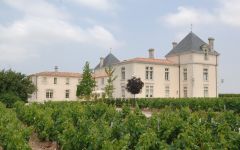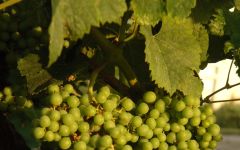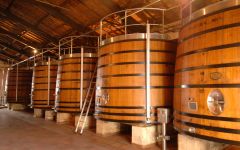Chateau de Pez 2019
-
Wine
Enthusiast -
Robert
Parker -
James
Suckling - Decanter
-
Wine
Spectator -
Jeb
Dunnuck




Product Details
Your Rating
Somm Note
Winemaker Notes
Blend: 56% Cabernet Sauvignon, 42% Merlot, 1% Cabernet Franc and 1% Petit Verdot
The Barrel Sample for this wine is above 14% ABV.
Professional Ratings
-
Wine Enthusiast
Spicy and structured, this is a classic Saint-Estèphe. Big tannins are boldly paired with the potential of the ripe black currant fruits that are juicy and fresh. The two sides of this wine are not yet together but do promise considerable aging.
Barrel Sample: 93-95 -
Robert Parker's Wine Advocate
This year's blend is 56% Cabernet Sauvignon, 42% Merlot, 1% Cabernet Franc and 1% Petit Verdot. Deep garnet-purple in color, the 2019 de Pez comes tumbling out of the glass with an astonishingly beautiful perfume of lilacs, black cherries and black raspberries over a core of stewed plums, clove oil, dark chocolate and Sichuan pepper. The medium-bodied palate is jam-packed with energetic black fruits, supported by a firm foundation of ripe, grainy tannins and lovely freshness, finishing long and perfumed. I love where this once-malingering château is headed—bravo to winemaker Nicolas Glumineau from Pichon Lalande!
Barrel Sample: 92-94+ -
James Suckling
Sweet berries with cedar and sandalwood, as well as flowers, such as lavender. Perfumed. Full-to medium-bodied with very polished and refined tannins that run the length of the wine. Very attractive and balanced.
-
Decanter
Owned by Pichon Comtesse, this is a lovely St Estèphe with polish and poise. Good depth to the berry fruits, with an appealing unfussy confidence. New cellars this year that allows for more precise reflection of the plots in 1% Petit Verdot completes the blend.
Barrel Sample: 93 -
Wine Spectator
Bright and fresh, featuring an upfront display of red and black currant preserve flavors, laced with black tea and backed by a nice iron twinge through the finish. Sneaky long, too. Cabernet Sauvignon, Merlot, Cabernet Franc and Petit Verdot.
-
Jeb Dunnuck
Currants, plums, new leather, and cedar pencil notes all emerge from the 2019 Château De Pez, a nicely balanced, medium to full-bodied Saint-Estèphe that has plenty of classic character as well as class. With ripe, polished tannins and terrific purity, it can be drunk any time over the coming 20-25 years.
Other Vintages
2022-
James
Suckling - Vinous
-
Jeb
Dunnuck -
Wine
Spectator -
Robert
Parker
-
Wine
Enthusiast -
James
Suckling - Decanter
- Vinous
-
Robert
Parker
-
Wine
Enthusiast - Decanter
-
Jeb
Dunnuck -
James
Suckling -
Wine
Spectator -
Robert
Parker
-
Jeb
Dunnuck -
Wine
Enthusiast -
James
Suckling - Decanter
-
Wine
Spectator -
Robert
Parker -
Wilfred
Wong
-
Wine
Enthusiast -
James
Suckling
-
Robert
Parker -
Wine
Enthusiast -
James
Suckling
-
Wine
Enthusiast -
Jeb
Dunnuck -
James
Suckling -
Robert
Parker
-
Robert
Parker -
Wine
Enthusiast -
James
Suckling
-
Wine
Enthusiast
-
Wine
Enthusiast -
James
Suckling
-
Wine
Spectator -
James
Suckling -
Wine
Enthusiast
-
Wine
Enthusiast -
James
Suckling -
Wine
Spectator
-
Wine
Enthusiast -
James
Suckling
-
Robert
Parker
-
Wine
Enthusiast -
Wine &
Spirits
-
Wine
Spectator
-
Wine
Enthusiast
-
Wine
Enthusiast -
Wine &
Spirits -
Wine
Spectator
-
Wine
Spectator
-
Wine
Enthusiast
-
Wine
Enthusiast
-
Wine
Spectator





Chateau de Pez is located west of the town of Saint-Estèphe. The estate consists of 74 contiguous acres, with 54 acres under vine. The vineyard is situated on a high plateau with well-exposed slopes. From a summit of 59 ft. the land descends northward to 39 ft.
Chateau de Pez remains resolutely faithful to wood. The blend is composed in December and the wine is stored in barrels where it is racked every three months. After approximately one year, roughly midway through the maturation process, the wine is fined using fresh egg whites. The wine is matured in small oak casks with 40% new oak, 30% "Premier vin", 30% "Deuxième vin". It should be noted that the wine undergoes absolutely no filtration.

One of the world’s most classic and popular styles of red wine, Bordeaux-inspired blends have spread from their homeland in France to nearly every corner of the New World. Typically based on either Cabernet Sauvignon or Merlot and supported by Cabernet Franc, Malbec and Petit Verdot, the best of these are densely hued, fragrant, full of fruit and boast a structure that begs for cellar time. Somm Secret—Blends from Bordeaux are generally earthier compared to those from the New World, which tend to be fruit-dominant.

Deeply colored, concentrated, and distinctive, St. Estephe is the go-to for great, age-worthy and reliable Bordeaux reds. Separated from Pauillac merely by a stream, St. Estephe is the farthest northwest of the highest classed villages of the Haut Medoc and is therefore subject to the most intense maritime influence of the Atlantic.
St. Estephe soils are rich in gravel like all of the best sites of the Haut Medoc but here the formation of gravel over clay creates a cooler atmosphere for its vines compared to those in the villages farther downstream. This results in delayed ripening and wines with higher acidity compared to the other villages.
While they can seem a bit austere when young, St. Estephe reds prove to live very long in the cellar. Traitionally dominated by Cabernet Sauvignon, many producers now add a significant proportion of Merlot to the blend, which will soften any sharp edges of the more tannic, Cabernet.
The St. Estephe village contains two second growths, Chateau Montrose and Cos d’Estournel.
